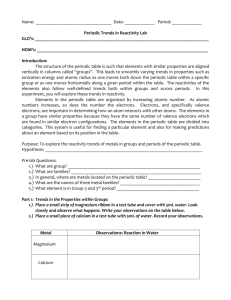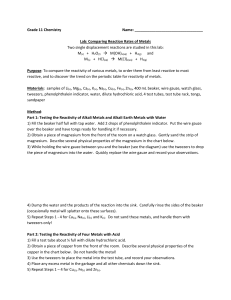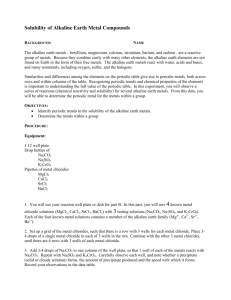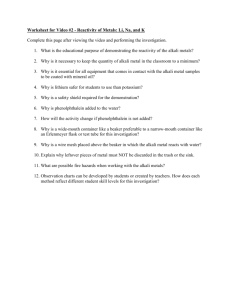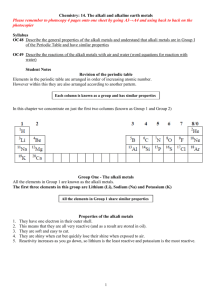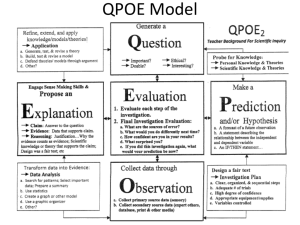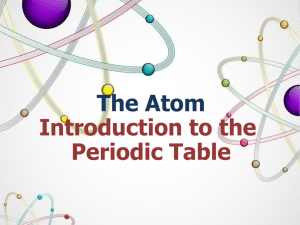Experiment: Periodic Properties of the Elements
advertisement
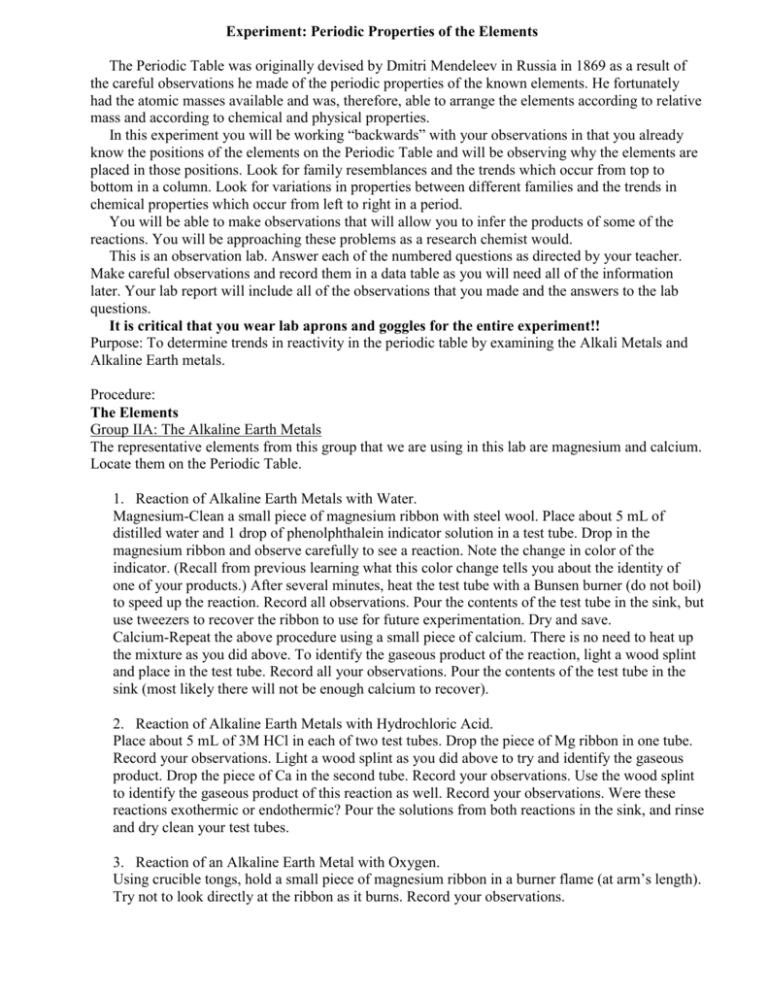
Experiment: Periodic Properties of the Elements The Periodic Table was originally devised by Dmitri Mendeleev in Russia in 1869 as a result of the careful observations he made of the periodic properties of the known elements. He fortunately had the atomic masses available and was, therefore, able to arrange the elements according to relative mass and according to chemical and physical properties. In this experiment you will be working “backwards” with your observations in that you already know the positions of the elements on the Periodic Table and will be observing why the elements are placed in those positions. Look for family resemblances and the trends which occur from top to bottom in a column. Look for variations in properties between different families and the trends in chemical properties which occur from left to right in a period. You will be able to make observations that will allow you to infer the products of some of the reactions. You will be approaching these problems as a research chemist would. This is an observation lab. Answer each of the numbered questions as directed by your teacher. Make careful observations and record them in a data table as you will need all of the information later. Your lab report will include all of the observations that you made and the answers to the lab questions. It is critical that you wear lab aprons and goggles for the entire experiment!! Purpose: To determine trends in reactivity in the periodic table by examining the Alkali Metals and Alkaline Earth metals. Procedure: The Elements Group IIA: The Alkaline Earth Metals The representative elements from this group that we are using in this lab are magnesium and calcium. Locate them on the Periodic Table. 1. Reaction of Alkaline Earth Metals with Water. Magnesium-Clean a small piece of magnesium ribbon with steel wool. Place about 5 mL of distilled water and 1 drop of phenolphthalein indicator solution in a test tube. Drop in the magnesium ribbon and observe carefully to see a reaction. Note the change in color of the indicator. (Recall from previous learning what this color change tells you about the identity of one of your products.) After several minutes, heat the test tube with a Bunsen burner (do not boil) to speed up the reaction. Record all observations. Pour the contents of the test tube in the sink, but use tweezers to recover the ribbon to use for future experimentation. Dry and save. Calcium-Repeat the above procedure using a small piece of calcium. There is no need to heat up the mixture as you did above. To identify the gaseous product of the reaction, light a wood splint and place in the test tube. Record all your observations. Pour the contents of the test tube in the sink (most likely there will not be enough calcium to recover). 2. Reaction of Alkaline Earth Metals with Hydrochloric Acid. Place about 5 mL of 3M HCl in each of two test tubes. Drop the piece of Mg ribbon in one tube. Record your observations. Light a wood splint as you did above to try and identify the gaseous product. Drop the piece of Ca in the second tube. Record your observations. Use the wood splint to identify the gaseous product of this reaction as well. Record your observations. Were these reactions exothermic or endothermic? Pour the solutions from both reactions in the sink, and rinse and dry clean your test tubes. 3. Reaction of an Alkaline Earth Metal with Oxygen. Using crucible tongs, hold a small piece of magnesium ribbon in a burner flame (at arm’s length). Try not to look directly at the ribbon as it burns. Record your observations. Group IA: The Alkali Metals The representative elements from this group that we are using in this lab are lithium, sodium and potassium each of which is stored in kerosene. Locate them on the Periodic Table. Handle these only with forceps. Blot the excess kerosene from the metal with paper towel. In the following experiments always keep the beaker at arm’s length. Collect small pieces of each of metals and place them on a paper towel. Keep track of which metal is which. 1. Relative Hardness of Alkali Metals. Cut into a small piece of each metal using a scupula or scalpel to observe how hard the metal is. Try to take into account the different thickness of each of your samples. 2. Reactivity of Alkali Metals with Oxygen. Observe how long each shiny cut takes to turn dull in air. (You are interested in the relative reactivity, more than with exact times.) You are observing how fast the metal reacts with oxygen to form an oxide tarnish that is dull. 3. Reactivity of Alkali Metals with Water. Put approximately 50 mL of distilled water in a 250 mL beaker. Add 1 drop of phenolphthalein indicator solution to the beaker. Drop a small piece of lithium metal into the beaker and immediately cover the top of the beaker with wire gauze. (The gaseous product is hydrogen gas, but for various reasons the flame test will not work to test for it.) Record all of your observations. Add any remaining pieces of lithium metal to the beaker. Pour the contents of the beaker in the sink and rinse well with water. Repeat the experiment with Na and K. Record all observations. Return all lab materials to their appropriate locations dispose of paper towels and clean off your desk. Periodic Table Lab Conclusion Questions. (Done in Lab Book) For each reaction you are asked to write, include the symbols for solid, liquid, gas or aqueous as determined from your experimental observations and balance the reaction. Group IIA: Alkaline Earth Metals 1. Write the equation that shows the reaction of calcium with water. 2. Write the equation which shows the reaction of Mg with HCl. Include the heat term. 3. Write the reaction of magnesium with oxygen. Include the heat term. 4. What happens to reactivity as you move down the column of the alkaline earth metals? Support directly using experimental evidence. Group IA: Alkali Metals 5. A. Write the equation which shows the reaction of sodium with water. B. What evidence is there that equations with the other alkali metals would be similar? C. Why do you think that these metals are stored in mineral oil? 6. A. Write the equation for the reaction of potassium with oxygen (the production of the “tarnish” that dulls the metal). B. What evidence is there that equation with the other alkali metals would be similar? 7. What trend do you see in the following characteristics as you go down the column of the alkali metals? Support directly using experimental evidence. A. Hardness B. Reactivity 8. What trend do you see in rate of reactivity with water as you go from left to right in a period on the Periodic Table? Support directly using experimental evidence.

